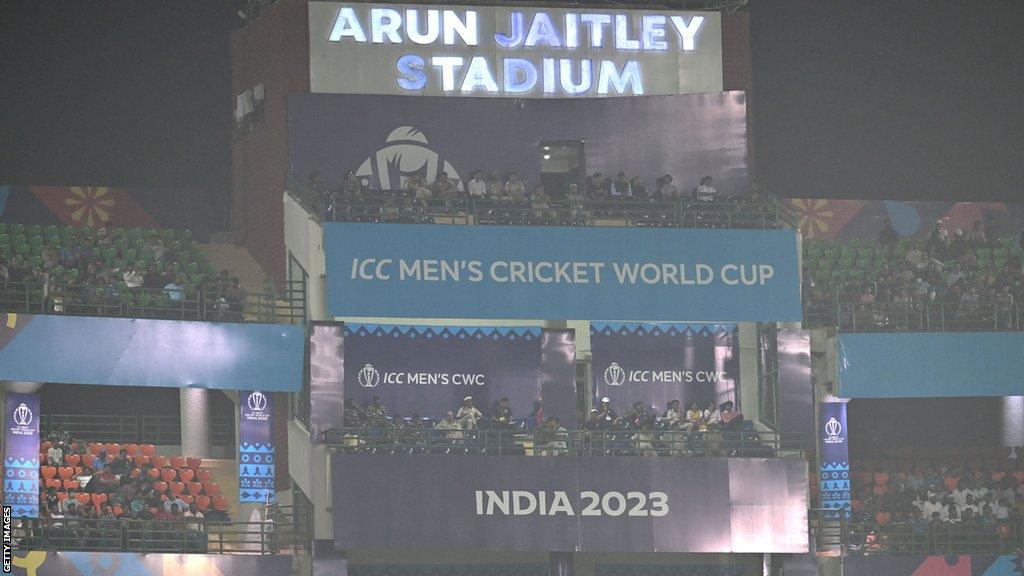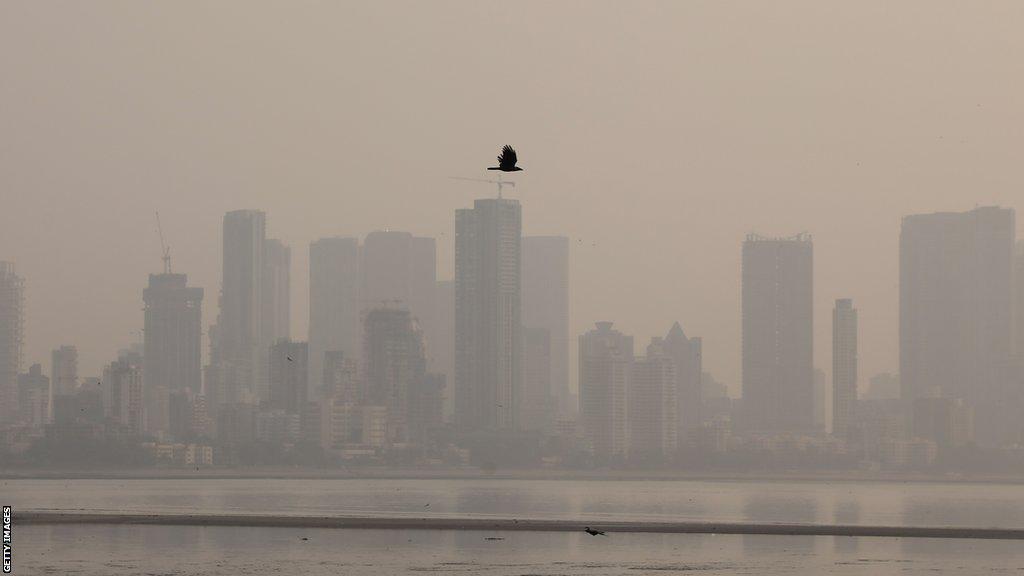Cricket World Cup 2023: India air pollution causes concern during tournament
- Published

Smog covered the Arun Jaitley stadium in Delhi during Bangladesh against Sri Lanka
Angelo Mathews getting timed out is what most people will remember from Sri Lanka's World Cup group match against Bangladesh in Delhi.
But in the build-up to the game at the Arun Jaitley stadium on 6 November, the air was the talking point.
The toxic air - a sooty, suffocating, blanket over a city that is home to more than 30 million people.
The Air Quality Index (AQI), which indicates the level of air pollution, rose past the scale's maximum value of 500 - 10 times the range considered 'good'.
In response, Delhi government closed primary schools and banned non-essential construction and demolition, as well as diesel vehicles entering the city.
Bangladesh and Sri Lanka cancelled training sessions. Some of the Bangladesh team did train the day before the game, mostly in masks. Those with asthma stayed away. Both teams publicly raised the issue of air quality.
Current International Cricket Council (ICC) guidelines don't mention air pollution directly, but allow the umpires to call a game off if they agree the conditions make play "dangerous or unreasonable".
In a last-ditch attempt to ensure the game went ahead, the ICC brought in pulmonologist Dr Randeep Guleria - former director of the All India Institute of Medical Sciences - who advised on mitigation, including the installation of water sprinklers around the stadium, while air purifiers were installed in the dressing rooms and match official areas.
By Monday morning, though air pollution outside the stadium was still very poor, and television footage from the match showed a city shrouded in haze, the final readings from the handheld monitors inside the stadium - which the ICC are yet to get from the Indian cricket board (BCCI) - were satisfactory enough for Dr Guleria to sign off.
Tom Moffat, the chief executive of international players' union FICA, expressed his concern.
"Player health and safety should always be a priority and clearly any time players feel they can't be outside to train or play that is an issue," he said.
"One of the challenges of international sport is that it is played in all sorts of conditions around the world.
"This is not a country specific issue and the game has more work to do on developing clearly published global standards that guide decision making in this area. They should be based on science and prioritise player wellbeing."
AQI measures the level of pollutants in the air, including PM 2.5 - tiny inhaled particles that can cause cancers and heart and lung disease, with evidence also emerging for associations with dementia, as well as low birth weight and Type 2 diabetes., external
The World Health Organisation (WHO) estimates the effects of air pollution is associated with seven million premature deaths every year.
The burning of fossil fuels accounts for 3.6 million of those deaths, according to research published in the Proceedings of the National Academy of Science., external
As a global partner of the ICC, state-owned Saudi oil giant Aramco has its logo displayed around the Delhi stadium that was covered in smog during Bangladesh against Sri Lanka.
Independent think tank Carbon Tracker says Aramco is "the world's largest corporate greenhouse gas emitter" and called its 2021 sustainability report "heavy on rhetoric and light on substance". Aramco says it has "one of the lowest upstream carbon footprints in the industry".
Delhi consistently ranks as one of the most polluted cities in the world, with seasonal smoke from stubble burning by farmers and Diwali fireworks adding to an already toxic brew of dust, vehicle emissions, pollution from construction, and emissions from industry and electricity generation.
For the past two weeks, the city's AQI has consistently been in the 400-500 'severe range', with a haze returning on Monday after the festival of Diwali.

Mumbai has been covered in heavy smog before India's semi-final against New Zealand
Delhi is not the only Indian city badly affected by air pollution in this World Cup.
England players used inhalers in cities with high pollution during their doomed title defence, and Joe Root was blunt in the news conference following defeat by South Africa in Mumbai.
"I've not played in anything like that before," he said.
"I've obviously played in hotter conditions, and probably more humid conditions. But it just felt like you couldn't get your breath. It was like you were eating the air. It was unique."
India captain Rohit Sharma also expressed his concern before their group game against Sri Lanka in Mumbai by saying "it's not ideal and everyone knows that".
It will be a worry again for India's semi-final against New Zealand in the same city on Wednesday. Swiss technology company IQAir recorded the air quality in Mumbai, external on Tuesday as 'unhealthy'.
Though there are not any specific studies on the effect of toxic air on cricketers, levels of air pollution are particularly dangerous to those exercising, as well as children, pregnant women, the infirm and the elderly.
"Immediate exposure to elevated levels of AQI can lead to various acute issues, such as breathing difficulties and increased blood pressure," said Dr Arvind Kumar, a senior lung specialist at the Medanta hospitals.
"Additionally, it can result in enduring respiratory symptoms, potentially reducing exercise capacity. Given that athletes engage in rigorous physical activity, they are at an increased risk of experiencing more severe breathing problems."
Rob Lynch, the chief executive of the Professional Cricketers' Association (PCA), has held discussions with other player associations in India on various issues, including air pollution.
"It is imperative that the welfare of professional cricketers is protected and safe playing conditions are paramount to this," the PCA said in a statement.
"The ICC has a duty of care to deem cities and venues as safe on and off the field."
England's men and women are due to tour India in the next few months.
The men's Test tour runs from late January to early March, when pollution should have eased, but the women play three T20s and a Test in Mumbai in December, with the A side playing three T20s starting at the end of this month. The ECB were unavailable for comment.
This is not a new problem for cricket in India - during the 2017 Test between India and Sri Lanka in Delhi, players wore masks and vomited because of high levels of pollution.
Nor is it just a problem in India, with IQAir's live ranking of the most polluted cities also featuring cricketing strongholds Lahore and Karachi in Pakistan, as well as Dhaka in Bangladesh, alongside Delhi, Kolkata and Mumbai in the top 15 on Tuesday.
For the young children in these cities dreaming of emulating their heroes and becoming a cricketer, the prognosis is particularly stark, with strong evidence that exercising in areas of high pollution stunts their lung function.